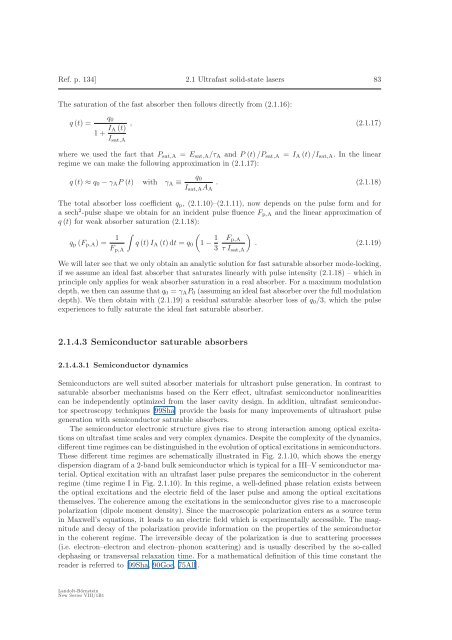2.1 Ultrafast solid-state lasers - ETH - the Keller Group
2.1 Ultrafast solid-state lasers - ETH - the Keller Group
2.1 Ultrafast solid-state lasers - ETH - the Keller Group
Create successful ePaper yourself
Turn your PDF publications into a flip-book with our unique Google optimized e-Paper software.
Ref. p. 134] <strong>2.1</strong> <strong>Ultrafast</strong> <strong>solid</strong>-<strong>state</strong> <strong>lasers</strong> 83<br />
The saturation of <strong>the</strong> fast absorber <strong>the</strong>n follows directly from (<strong>2.1</strong>.16):<br />
q (t) =<br />
q 0<br />
1+ I A (t)<br />
I sat,A<br />
, (<strong>2.1</strong>.17)<br />
whereweused<strong>the</strong>factthatP sat,A = E sat,A /τ A and P (t) /P sat,A = I A (t) /I sat,A . In <strong>the</strong> linear<br />
regime we can make <strong>the</strong> following approximation in (<strong>2.1</strong>.17):<br />
q (t) ≈ q 0 − γ A P (t) with γ A ≡<br />
q 0<br />
I sat,A A A<br />
. (<strong>2.1</strong>.18)<br />
The total absorber loss coefficient q p , (<strong>2.1</strong>.10)–(<strong>2.1</strong>.11), now depends on <strong>the</strong> pulse form and for<br />
a sech 2 -pulse shape we obtain for an incident pulse fluence F p,A and <strong>the</strong> linear approximation of<br />
q (t) for weak absorber saturation (<strong>2.1</strong>.18):<br />
q p (F p,A )= 1<br />
F p,A<br />
∫<br />
q (t) I A (t)dt = q 0<br />
(<br />
1 − 1 3<br />
)<br />
F p,A<br />
. (<strong>2.1</strong>.19)<br />
τI sat,A<br />
We will later see that we only obtain an analytic solution for fast saturable absorber mode-locking,<br />
if we assume an ideal fast absorber that saturates linearly with pulse intensity (<strong>2.1</strong>.18) – which in<br />
principle only applies for weak absorber saturation in a real absorber. For a maximum modulation<br />
depth, we <strong>the</strong>n can assume that q 0 = γ A P 0 (assuming an ideal fast absorber over <strong>the</strong> full modulation<br />
depth). We <strong>the</strong>n obtain with (<strong>2.1</strong>.19) a residual saturable absorber loss of q 0 /3, which <strong>the</strong> pulse<br />
experiences to fully saturate <strong>the</strong> ideal fast saturable absorber.<br />
<strong>2.1</strong>.4.3 Semiconductor saturable absorbers<br />
<strong>2.1</strong>.4.3.1 Semiconductor dynamics<br />
Semiconductors are well suited absorber materials for ultrashort pulse generation. In contrast to<br />
saturable absorber mechanisms based on <strong>the</strong> Kerr effect, ultrafast semiconductor nonlinearities<br />
can be independently optimized from <strong>the</strong> laser cavity design. In addition, ultrafast semiconductor<br />
spectroscopy techniques [99Sha] provide <strong>the</strong> basis for many improvements of ultrashort pulse<br />
generation with semiconductor saturable absorbers.<br />
The semiconductor electronic structure gives rise to strong interaction among optical excitations<br />
on ultrafast time scales and very complex dynamics. Despite <strong>the</strong> complexity of <strong>the</strong> dynamics,<br />
different time regimes can be distinguished in <strong>the</strong> evolution of optical excitations in semiconductors.<br />
These different time regimes are schematically illustrated in Fig. <strong>2.1</strong>.10, which shows <strong>the</strong> energy<br />
dispersion diagram of a 2-band bulk semiconductor which is typical for a III–V semiconductor material.<br />
Optical excitation with an ultrafast laser pulse prepares <strong>the</strong> semiconductor in <strong>the</strong> coherent<br />
regime (time regime I in Fig. <strong>2.1</strong>.10). In this regime, a well-defined phase relation exists between<br />
<strong>the</strong> optical excitations and <strong>the</strong> electric field of <strong>the</strong> laser pulse and among <strong>the</strong> optical excitations<br />
<strong>the</strong>mselves. The coherence among <strong>the</strong> excitations in <strong>the</strong> semiconductor gives rise to a macroscopic<br />
polarization (dipole moment density). Since <strong>the</strong> macroscopic polarization enters as a source term<br />
in Maxwell’s equations, it leads to an electric field which is experimentally accessible. The magnitude<br />
and decay of <strong>the</strong> polarization provide information on <strong>the</strong> properties of <strong>the</strong> semiconductor<br />
in <strong>the</strong> coherent regime. The irreversible decay of <strong>the</strong> polarization is due to scattering processes<br />
(i.e. electron–electron and electron–phonon scattering) and is usually described by <strong>the</strong> so-called<br />
dephasing or transversal relaxation time. For a ma<strong>the</strong>matical definition of this time constant <strong>the</strong><br />
reader is referred to [99Sha, 90Goe, 75All].<br />
Landolt-Börnstein<br />
New Series VIII/1B1
















